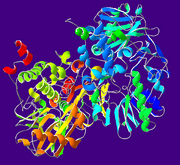 Monoamine oxidase
| ||||||||||||||||||||||||||||||||
Monoamine oxidases (singular abbreviation MAO) (EC 1.4.3.4) are enzymes that catalyze the oxidation of monoamines. They are found bound to the outer membrane of mitochondria in most cell types in the body.
There are two types of MAO: MAO-A and MAO-B. Both are found in neurons and astroglia; MAO-A is also found in the liver, gastrointestinal tract and placenta. Outside the central nervous system, MAO-B is mostly found in blood platelets.
Function
Monoamine oxidases catalyze the oxidative deamination of monoamines. Oxygen is used to remove an amine group from a molecule, resulting in the corresponding aldehyde and ammonia. The general form of the catalized reaction (with R denoting an arbitrary group) is
H H
R-C-NH2 + O2 + H2O → R-C=O + NH3 + H2O2
H
Monoamine oxidase contains the covalently-bound cofactor FAD.
Subtype Specificities
MAO-A is particularly important in the catabolism of monoamines ingested in food. Both MAOs are also vital to the inactivation of monoaminergic neurotransmitters, for which they display different specificities. Thus, serotonin is mainly broken down by MAO-A, as is norepinephrine (noradrenaline) and epinephrine (adrenaline), while phenethylamine is broken down by MAO-B. Both forms break down dopamine.
Genetic, high levels of MAOA have been reported (Caspi et al, date) to provide protection from the detrimental effects of being maltreated as childen.
Brain imaging studies by Meyer-Lindenberg et al (2006)found that men who had a genotype leading to low expression of MAOA (now identified as a risk factor for violent behavior)showed reduced functioning in thei anterior cingulate cortex when they tried to inhibit a physical response, and exaggerated amygdala funtioning suggestive of heightened anxiety and fearfulness
Genetics
The genes encoding MAO-A and MAO-B are both located on the short arm of the X chromosome. These two genes are to be found side-by-side, and have about 70% homology.
Disorders resulting from MAO dysfunction
Assessment |
Biopsychology |
Comparative |
Cognitive |
Developmental |
Language |
Individual differences |
Personality |
Philosophy |
Social |
Methods |
Statistics |
Clinical |
Educational |
Industrial |
Professional items |
World psychology |
Biological: Behavioural genetics · Evolutionary psychology · Neuroanatomy · Neurochemistry · Neuroendocrinology · Neuroscience · Psychoneuroimmunology · Physiological Psychology · Psychopharmacology (Index, Outline)
Because of the vital role that MAOs play in the inactivation of neurotransmitters, MAO dysfunction (too much/too little MAO activity) is thought to be responsible for a number of neurological disorders. For example, unusually high or low levels of MAOs in the body have been associated with depression, substance abuse, criminality, attention deficit disorder, and social phobias. Monoamine oxidase inhibitors are one of the major classes of drug prescribed for the treatment of depression.
Recent PET research has shown that MAO is also heavily depleted by tobacco use. Another interesting study reported in August 2002 concluded that "maltreated children with a genotype conferring high levels of MAO-A expression were less likely to develop antisocial problems" (Caspi 2002).
Recent research uncovered a possible link between predisposition to novelty seeking and increased levels of MAO-A. [1]
Reference
- Caspi, A. Moffitt, T.E. et al. 2002. Role of genotype in the cycle of violence in maltreated children. Science 297 (Aug. 2):851-854. PMID 12161658
External links
- MAO-B Structure
- Monoamine oxidase (MAO)
- Slides showing the effects of tobacco smoking on MAO
- Foods to avoid when taking MAO inhibitors
| This page uses Creative Commons Licensed content from Wikipedia (view authors). |